
A prisoner of war (POW) is a person who is held captive by a belligerent power during or immediately after an armed conflict. The earliest recorded usage of the phrase "prisoner of war" dates back to 1610.
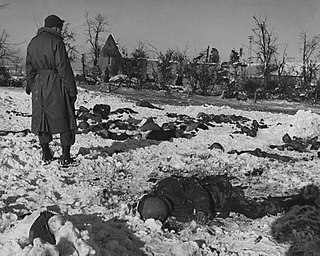
A war crime is a violation of the laws of war that gives rise to individual criminal responsibility for actions by combatants in action, such as intentionally killing civilians or intentionally killing prisoners of war, torture, taking hostages, unnecessarily destroying civilian property, deception by perfidy, wartime sexual violence, pillaging, and for any individual that is part of the command structure who orders any attempt to committing mass killings including genocide or ethnic cleansing, the granting of no quarter despite surrender, the conscription of children in the military and flouting the legal distinctions of proportionality and military necessity.
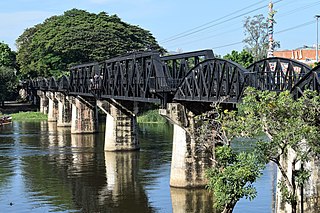
The Burma Railway, also known as the Siam–Burma Railway, Thai–Burma Railway and similar names, or as the Death Railway, is a 415 km (258 mi) railway between Ban Pong, Thailand, and Thanbyuzayat, Burma. It was built from 1940 to 1943 by South East Asian civilians abducted and forced to work by the Japanese and a smaller group of captured Allied soldiers, to supply troops and weapons in the Burma campaign of World War II. It completed the rail link between Bangkok, Thailand, and Rangoon, Burma. The name used by the Japanese Government was Tai–Men Rensetsu Tetsudō (泰緬連接鉄道), which means Thailand-Burma-Link-Railway.

Unit 731, short for Manchu Detachment 731 and also known as the Kamo Detachment and the Ishii Unit, was a covert biological and chemical warfare research and development unit of the Imperial Japanese Army that engaged in lethal human experimentation and biological weapons manufacturing during the Second Sino-Japanese War (1937–1945) and World War II. Estimates vary as to how many were killed. Between 1936 to 1945, roughly 14,000 victims were murdered in Unit 731. It is estimated that at least 300,000 individuals have died due to infectious illnesses caused by the activities of Unit 731 and its affiliated research facilities. It was based in the Pingfang district of Harbin, the largest city in the Japanese puppet state of Manchukuo and had active branch offices throughout China and Southeast Asia.

The Bataan Death March was the forcible transfer by the Imperial Japanese Army of 75,000 American and Filipino prisoners of war (POW) from the municipalities of Bagac and Mariveles on the Bataan Peninsula to Camp O'Donnell via San Fernando.

The International Military Tribunal for the Far East (IMTFE), also known as the Tokyo Trial and the Tokyo War Crimes Tribunal, was a military trial convened on 29 April 1946 to try leaders of the Empire of Japan for their crimes against peace, conventional war crimes, and crimes against humanity, leading up to and during the Second World War. The IMTFE was modeled after the International Military Tribunal (IMT) at Nuremberg, Germany, which prosecuted the leaders of Nazi Germany for their war crimes, crimes against peace, and crimes against humanity.
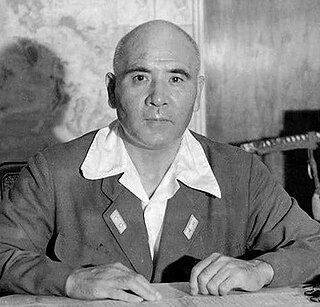
Masaharu Homma was a lieutenant general in the Imperial Japanese Army during World War II. Homma commanded the Japanese 14th Army, which invaded the Philippines and perpetrated the Bataan Death March. After the war, Homma was convicted of war crimes relating to the actions of troops under his direct command and executed by firing squad on April 3, 1946.
The Commando Order was issued by the OKW, the high command of the German Armed Forces, on 18 October 1942. This order stated that all Allied commandos captured in Europe and Africa should be summarily executed without trial, even if in proper uniforms or if they attempted to surrender. Any commando or small group of commandos or a similar unit, agents, and saboteurs not in proper uniforms who fell into the hands of the German forces by some means other than direct combat, were to be handed over immediately to the Sicherheitsdienst for immediate execution.
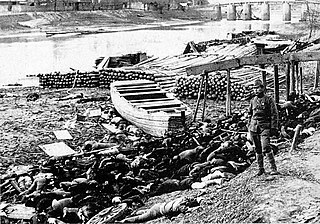
During its imperial era, the Empire of Japan committed numerous war crimes and crimes against humanity across various Asian-Pacific nations, notably during the Second Sino-Japanese and Pacific Wars. These incidents have been referred to as "the Asian Holocaust", and "Japan's Holocaust", and also as the "Rape of Asia". The crimes occurred during the early part of the Shōwa era, under Hirohito's reign.

The Sandakan Death Marches were a series of forced marches in Borneo from Sandakan to Ranau which resulted in the deaths of 2,434 Allied prisoners of war held captive by the Empire of Japan during the Pacific campaign of World War II at the Sandakan POW Camp, North Borneo. By the end of the war, of all the prisoners who had been incarcerated at Sandakan and Ranau, only six Australians survived, all of whom had escaped. It is widely considered to be the single worst atrocity suffered by Australian servicemen during the Second World War.

During World War II, the Allies committed legally proven war crimes and violations of the laws of war against either civilians or military personnel of the Axis powers. At the end of World War II, many trials of Axis war criminals took place, most famously the Nuremberg Trials and Tokyo Trials. In Europe, these tribunals were set up under the authority of the London Charter, which only considered allegations of war crimes committed by people who acted in the interests of the Axis powers. Some war crimes involving Allied personnel were investigated by the Allied powers and led in some instances to courts-martial. Some incidents alleged by historians to have been crimes under the law of war in operation at the time were, for a variety of reasons, not investigated by the Allied powers during the war, or were investigated but not prosecuted.

A hell ship is a ship with extremely inhumane living conditions or with a reputation for cruelty among the crew. It now generally refers to the ships used by the Imperial Japanese Navy and Imperial Japanese Army to transport Allied prisoners of war (POWs) and rōmusha out of the Philippines, the Dutch East Indies, Hong Kong, and Singapore in World War II. These POWs were taken to the Japanese Islands, Formosa, Manchukuo, Korea, the Moluccas, Sumatra, Burma, or Siam to be used as forced labor.
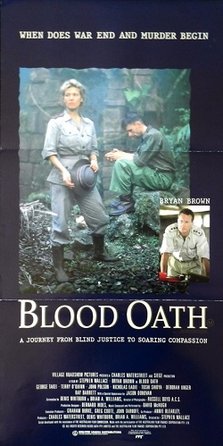
Blood Oath, known in some countries as Prisoners of the Sun, is a 1990 Australian drama film directed by Stephen Wallace and co-written by Denis Whitburn and Brian A. Williams. The film stars Bryan Brown, George Takei, Terry O'Quinn, John Bach, John Clarke, Deborah Kara Unger, Russell Crowe, John Polson, Nicholas Eadie, David Argue and Ray Barrett. The film is based on the real-life trial of Japanese soldiers for war crimes committed against Allied prisoners of war on the island of Ambon, in the Netherlands East Indies (Indonesia), such as the Laha massacre of 1942.
A war crimes trial is the trial of persons charged with criminal violation of the laws and customs of war and related principles of international law committed during armed conflict.

Ōryoku Maru was a Japanese passenger cargo ship which was commissioned by the Imperial Japanese Navy during World War II as a troop transport and prisoner of war (POW) transport ship. Japanese POW transport ships are often referred to as hell ships, due to their notoriously unpleasant conditions and the many deaths that occurred on board. In December 1944, the ship was bombed by American aircraft, killing 200 Allied POWs. Hundreds more died in the months that followed.
The United States Armed Forces and its members have violated the law of war after the signing of the Hague Conventions of 1899 and 1907 and the signing of the Geneva Conventions. The United States prosecutes offenders through the War Crimes Act of 1996 as well as through articles in the Uniform Code of Military Justice. The United States signed the 1999 Rome Statute but it never ratified the treaty, taking the position that the International Criminal Court (ICC) lacks fundamental checks and balances. The American Service-Members' Protection Act of 2002 further limited US involvement with the ICC. The ICC reserves the right of states to prosecute war crimes, and the ICC can only proceed with prosecution of crimes when states do not have willingness or effective and reliable processes to investigate for themselves. The United States says that it has investigated many of the accusations alleged by the ICC prosecutors as having occurred in Afghanistan, and thus does not accept ICC jurisdiction over its nationals.

During World War II, it was estimated that between 35,000 and 50,000 members of the Imperial Japanese Armed Forces surrendered to Allied service members prior to the end of World War II in Asia in August 1945. Also, Soviet troops seized and imprisoned more than half a million Japanese troops and civilians in China and other places. The number of Japanese soldiers, sailors, marines, and airmen who surrendered was limited by the Japanese military indoctrinating its personnel to fight to the death, Allied combat personnel often being unwilling to take prisoners, and many Japanese soldiers believing that those who surrendered would be killed by their captors.
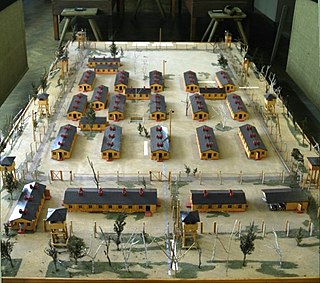
The Stalag Luft III murders were war crimes perpetrated by members of the Gestapo following the "Great Escape" of Allied prisoners of war from the German Air Force prison camp known as Stalag Luft III on March 25, 1944. Of the 76 successful escapees, 73 were recaptured, most within several days of the breakout, 50 of whom were executed on the personal orders of Adolf Hitler. These executions were conducted shortly after the prisoners' recapture.

The Palawan massacre occurred on 14 December 1944, during World War II, near the city of Puerto Princesa in the Philippine province of Palawan. Allied soldiers, imprisoned near the city, were killed by Imperial Japanese soldiers. Only eleven men managed to survive.
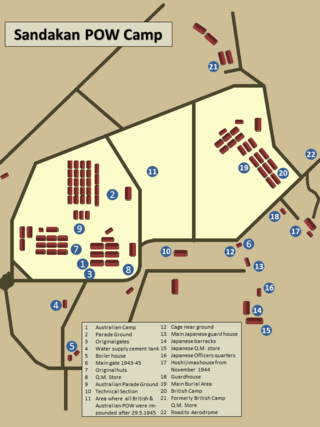
The Sandakan camp, also known as Sandakan POW Camp, was a prisoner-of-war camp established during World War II by the Japanese in Sandakan in the Malaysian state of Sabah. This site has gained notoriety as the Sandakan Death Marches started from here. Now, part of the former site houses the Sandakan Memorial Park.
















